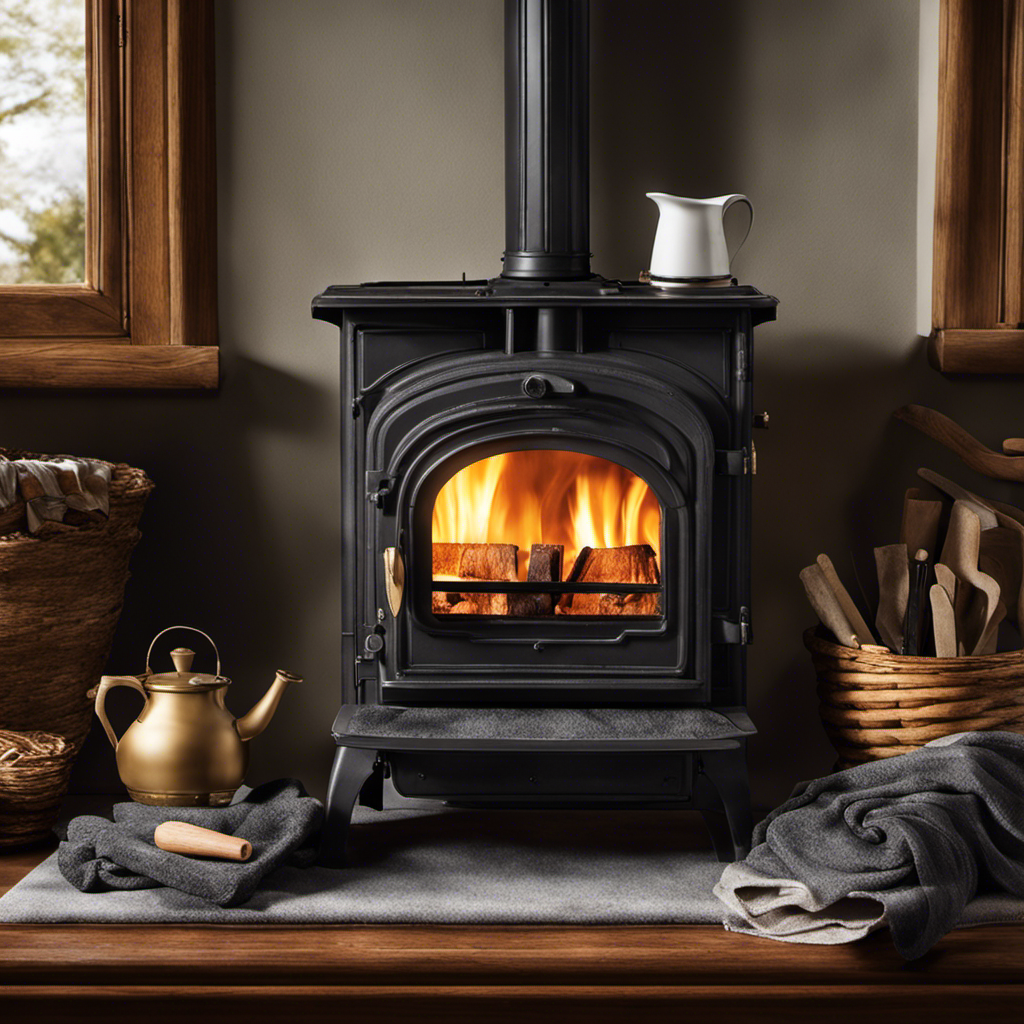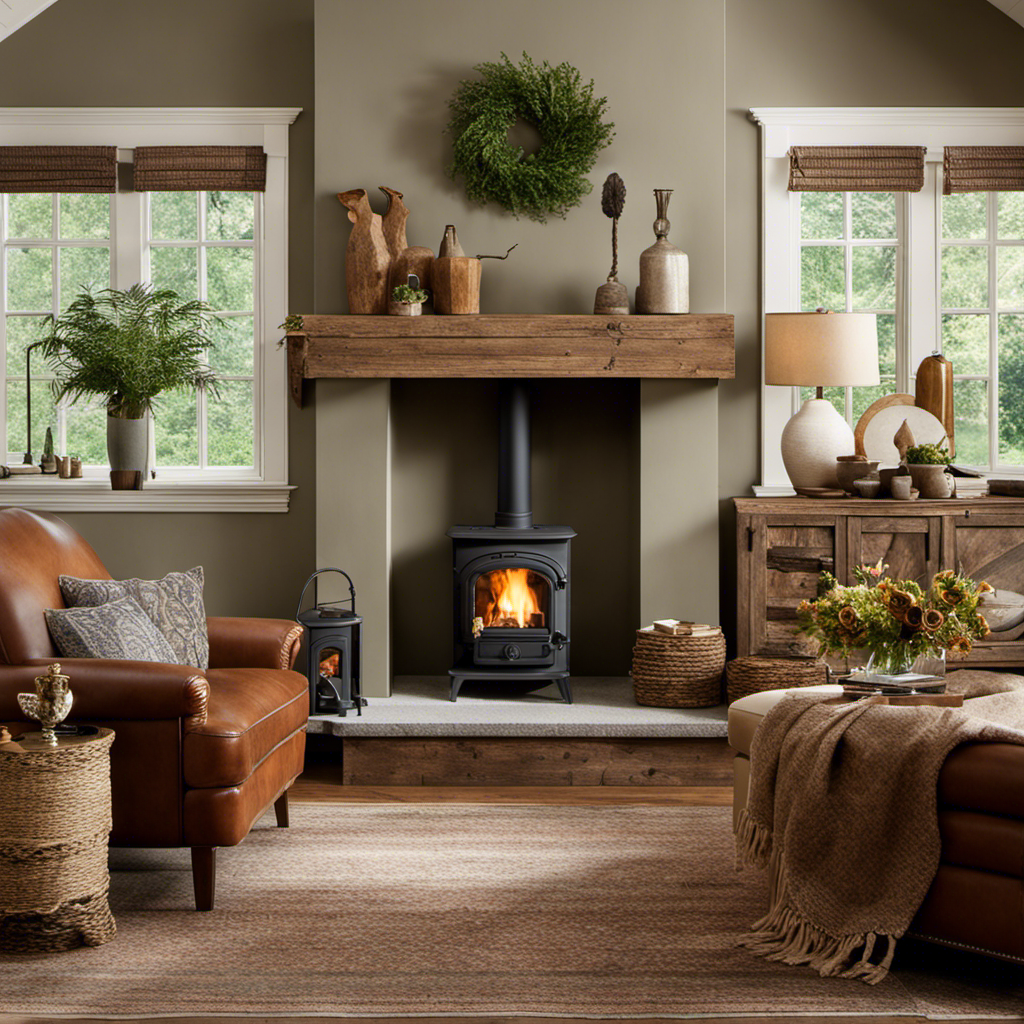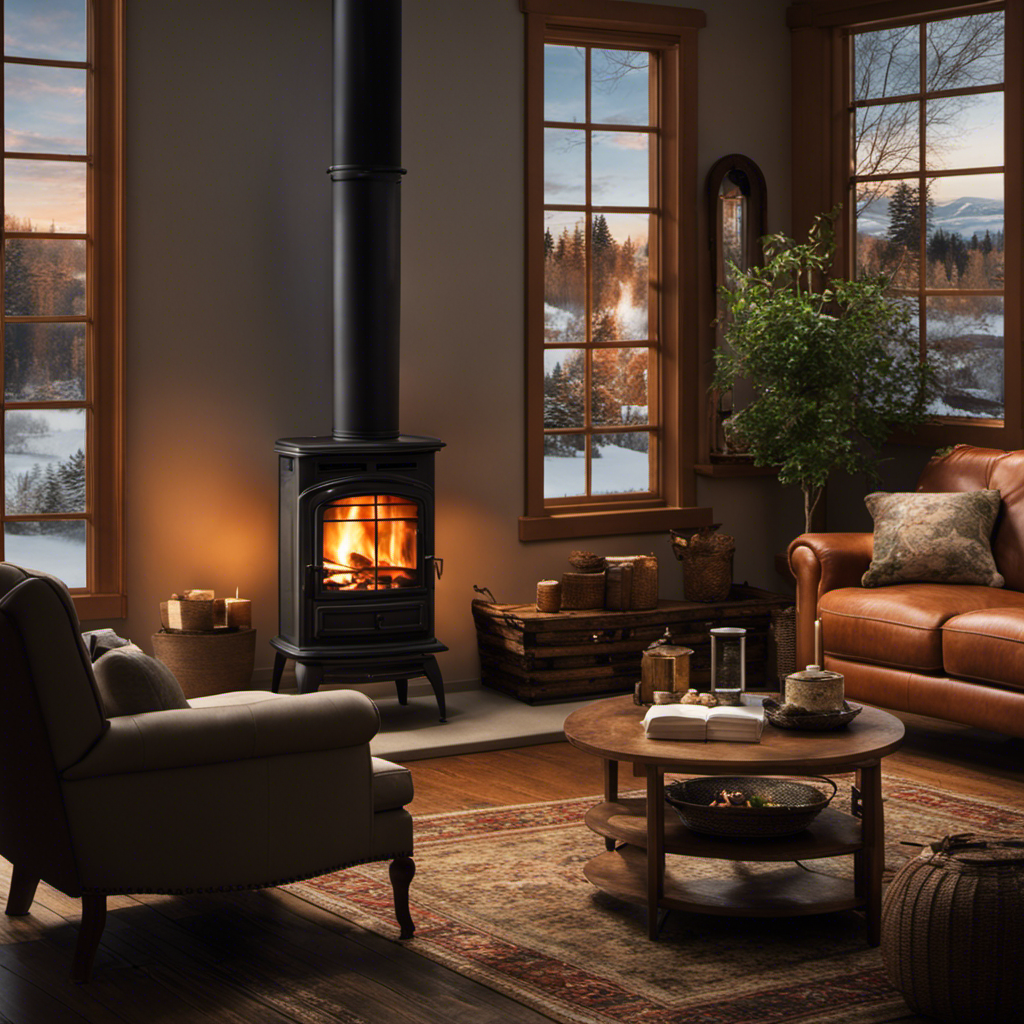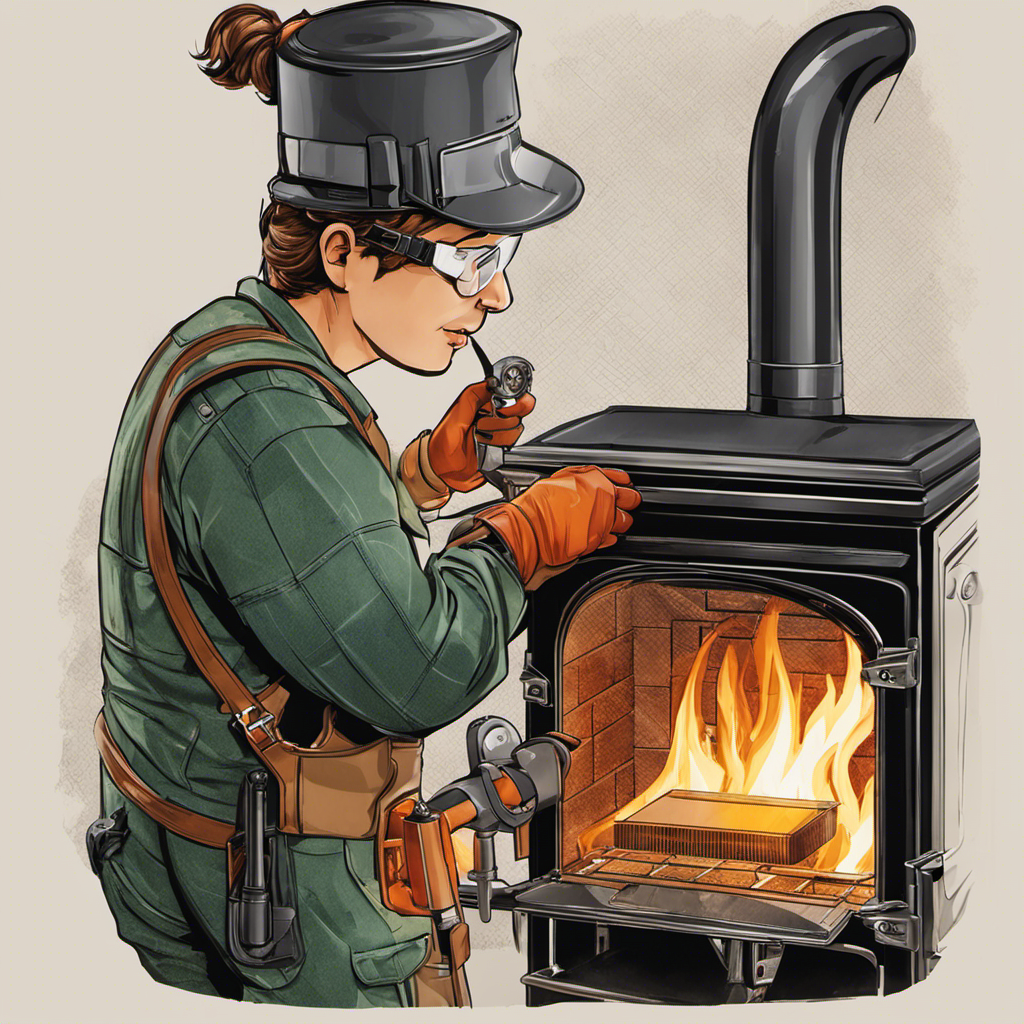I’ve always held a fond appreciation for the cozy warmth that comes from a wood stove, yet maintaining it has proven to be somewhat difficult. Fortunately, I’ve come across a few simple methods that have simplified the cleaning process.
In this article, I’ll walk you through the techniques I use to keep my wood stove spotless and running efficiently. From removing ashes to scrubbing the glass door, I’ll share all the tips and tricks you need to maintain your wood stove like a pro.
Let’s get started!
Key Takeaways
- Gather protective gear and essential tools before starting the cleaning process
- Use a vacuum designed for ash removal with a HEPA filter to safely remove ashes from the stove
- Clean the firebox thoroughly using warm water and mild soap, and rinse and dry it before lighting another fire
- Scrub the glass door with a non-abrasive sponge and stove glass cleaner to remove soot stains and ensure clear visibility
Preparing for Cleaning
Before starting the cleaning process, I should gather all the necessary materials. Proper preparation is key to effectively clean a wood stove. The pre-cleaning steps ensure that I’ve everything I need to tackle the task efficiently.
Firstly, I need to have protective gear such as gloves and safety glasses to keep myself safe from any potential hazards. Cleaning a wood stove can be messy and potentially dangerous, so it’s important to prioritize safety.
Next, I should gather a few essential tools. A wire brush is essential for scrubbing away any built-up soot and creosote. It’s important to choose a brush specifically designed for use on wood stoves to avoid damaging the surface. Additionally, a vacuum cleaner with a brush attachment is useful for removing ash and debris from inside the stove.
Other necessary materials include a metal bucket or container to collect the ash, newspaper or drop cloths to protect the surrounding area, and a cleaning solution specifically formulated for wood stoves. It’s important to choose a non-toxic cleaner to ensure the safety of the stove and its users.
Removing Ashes
I always make sure to wear gloves when removing the ashes from my wood stove. It’s an important safety measure to protect my hands from any hot embers that may still be lingering.
When it comes to cleaning a wood stove, removing the ashes is a crucial step. Not only does it help maintain the efficiency of the stove, but it also prevents any potential fire hazards. To remove the ashes, I use a vacuum specifically designed for ash removal. This device is equipped with a high-efficiency particulate air (HEPA) filter, which ensures that fine ash particles are contained and not released into the air.
I carefully vacuum the ashes, making sure to cover the entire surface area of the stove, including the firebox and any surrounding areas.
Once the ashes are vacuumed, it’s important to dispose of them properly. I allow the ashes to cool completely before transferring them to a metal container with a tight-fitting lid. This helps prevent any potential fire risk from smoldering ashes.
I then take the container to an outdoor area away from any flammable materials and dispose of the ashes in a designated ash disposal area.
Cleaning the Firebox
When removing the ashes, it’s important to pay close attention to the firebox and ensure that it’s thoroughly cleaned. The firebox is the heart of your wood stove, where the fuel is burned and the heat is generated. Neglecting its maintenance can lead to reduced efficiency and potential safety hazards.
To clean the firebox effectively, follow these steps:
- Allow the stove to cool down completely before starting the cleaning process.
- Use a small brush or vacuum cleaner to remove any loose soot or debris from the firebox.
- For a more thorough cleaning, mix a solution of warm water and mild soap.
- Dip a sponge or cloth into the solution and gently scrub the interior walls of the firebox, focusing on areas with heavy soot buildup.
- Rinse the sponge or cloth with clean water and wipe away any soap residue.
- Dry the firebox thoroughly before lighting another fire.
Scrubbing the Glass Door
The glass door of my stove needs a good scrubbing to remove any soot or debris. Glass door maintenance is an essential part of keeping a wood stove in good condition.
Over time, soot can build up on the glass, making it difficult to see the fire inside. To prevent this buildup, it’s important to clean the glass regularly.
To start, I gather a few supplies: a non-abrasive sponge, warm water, and a stove glass cleaner. I make sure the stove is completely cool before beginning the cleaning process.
Then, I dampen the sponge with warm water and apply a small amount of the stove glass cleaner. I gently scrub the glass door in a circular motion, paying close attention to any areas with stubborn soot stains.
Once I’ve thoroughly scrubbed the glass, I use a clean, damp cloth to wipe away any excess cleaner. It’s important to dry the glass completely to prevent streaks or water spots. I’m always careful not to use any abrasive materials or harsh chemicals that could damage the glass.
Cleaning the Chimney
Regularly maintaining the chimney ensures proper ventilation and reduces the risk of chimney fires. Chimney maintenance is an essential task that should be done at least once a year. As a homeowner, I understand the importance of keeping my chimney in top shape to ensure the safety and efficiency of my wood stove.
One of the key aspects of chimney maintenance is cleaning the chimney. This is where chimney sweep services come into play. Chimney sweep services are specialized professionals who have the knowledge and expertise to thoroughly clean and inspect chimneys. They use specialized tools and equipment to remove creosote buildup, debris, and blockages that can hinder proper ventilation and increase the risk of chimney fires. During the cleaning process, they also inspect the chimney for any signs of damage or deterioration, ensuring that any issues are addressed promptly.
Hiring a chimney sweep service is a wise investment for any homeowner with a wood stove. It not only ensures the safety of your home and family but also improves the efficiency and performance of your wood stove. So, if you haven’t had your chimney cleaned in a while, it’s time to contact a professional chimney sweep service and schedule a maintenance appointment. Trust me, you won’t regret it.
Maintaining the Exterior
As a homeowner, I take pride in keeping the exterior of my house well-maintained to enhance its curb appeal and protect it from the elements. This includes regular maintenance of my wood stove, which not only ensures its longevity but also promotes safe and efficient wood burning. One important aspect of wood stove maintenance is keeping the exterior clean and free from debris. To accomplish this, I use a variety of cleaning tools specifically designed for wood stoves.
| Cleaning Tools | Description |
|---|---|
| Ash Shovel | Used to scoop out ashes and debris from the firebox. |
| Wire Brush | Ideal for removing soot and buildup from the stove’s surface. |
| Vacuum Cleaner | Equipped with a special attachment, it effectively sucks up ash and dust. |
| Microfiber Cloth | Perfect for wiping down the exterior and leaving a streak-free finish. |
Regularly cleaning the exterior of my wood stove not only keeps it looking its best, but it also helps to prevent the buildup of creosote, a highly flammable substance that can accumulate on the stove’s surface. By maintaining a clean stove, I can ensure that it operates efficiently and safely.
Now that we’ve covered the importance of maintaining the exterior of a wood stove, let’s move on to some essential tips for safe and efficient wood burning.
Tips for Safe and Efficient Wood Burning
To ensure safe and efficient wood burning, I always use dry and seasoned firewood. Using wet or unseasoned firewood can lead to inefficient burning, excessive smoke, and the build-up of creosote in the chimney, which can increase the risk of chimney fires. Dry and seasoned firewood, on the other hand, burns hotter and cleaner, providing better heat output and reducing the amount of smoke produced.
In addition to using dry and seasoned firewood, there are a few other wood stove safety tips to keep in mind. First, it’s important to have your chimney inspected and cleaned regularly by a professional to remove any creosote build-up and ensure proper ventilation. Second, make sure to keep flammable materials at least three feet away from the stove to prevent accidental fires. Finally, always use a screen or glass door to prevent sparks from escaping and causing a fire hazard.
Aside from the safety considerations, there are also several benefits to wood burning. Wood is a renewable energy source, and burning it releases less greenhouse gases compared to fossil fuels. It can also be a cost-effective heating option, especially if you’ve access to free or low-cost firewood. Additionally, the ambiance and warmth provided by a wood stove can create a cozy and inviting atmosphere in your home.
Frequently Asked Questions
How Often Should I Clean My Wood Stove?
I clean my wood stove regularly to ensure it operates efficiently and safely. Cleaning frequency depends on usage, but generally, it’s recommended to clean the stove at least once a month during the burning season.
Regular cleaning is important to remove ash, soot, and creosote buildup, which can reduce the stove’s efficiency and increase the risk of chimney fires.
Additionally, a clean wood stove will produce less smoke and emit fewer pollutants into the environment.
Can I Use Regular Household Cleaners to Clean My Wood Stove?
Regular household cleaners may not be the best option for cleaning a wood stove. They often contain chemicals that can leave behind residue or emit harmful fumes when exposed to high temperatures. Instead, consider using alternative options specifically designed for wood stove cleaning.
These cleaners are formulated to effectively remove soot, creosote, and other built-up debris without causing damage or posing health risks. It’s important to prioritize safety and choose the right products for maintaining your wood stove.
What Should I Do if There Is a Build-Up of Creosote in the Chimney?
If there’s a build-up of creosote in the chimney, it’s important to address it promptly for safety reasons. Removing creosote buildup in the chimney requires proper cleaning techniques for a wood stove.
One option is to hire a professional chimney sweep who’s the necessary tools and expertise. Another option is to use a creosote removal product specifically designed for wood stoves.
Regular maintenance and cleaning of the chimney will help prevent creosote buildup in the future.
Is It Safe to Clean the Glass Door While the Stove Is Still Hot?
When it comes to cleaning the glass door of a wood stove, safety should always be the priority. It isn’t safe to clean the glass door while the stove is still hot. The high temperatures can cause burns or injuries.
It’s important to wait for the stove to cool down before attempting to clean the glass. There are alternative cleaning methods that can be used, such as using a specialized glass cleaner or a mixture of vinegar and water.
How Can I Prevent Smoke From Escaping Into the Room When Cleaning the Firebox?
To prevent smoke from escaping into the room while cleaning the firebox, there are a few techniques you can try.
First, make sure the stove is completely cool before starting.
Next, open the damper to allow for proper ventilation.
Use a brush or vacuum to remove any ashes or debris from the firebox.
Conclusion
In conclusion, maintaining a clean wood stove is essential for its safe and efficient operation.
Did you know that according to the National Fire Protection Association, 27% of home heating fires are caused by heating equipment, including wood stoves?
By regularly cleaning your wood stove, you can significantly reduce the risk of fire and ensure its longevity.
Remember to follow the outlined steps and tips to keep your wood stove in excellent condition and enjoy its warmth for years to come.
Logan’s affair with adventure began in childhood. He hailed from a small town where vast forests bordered one side and endless shores stretched on the other. His days were spent exploring uncharted woods, climbing tall trees, or listening to the tales of old sailors. This early immersion in a world brimming with stories and mysteries became the foundation of his passion for writing.











